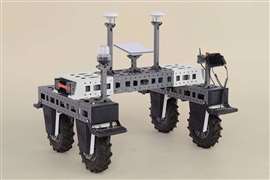Read this article in Français Deutsch Italiano Português Español
Detroit Manufacturing Systems to produce InductEV hardware
11 January 2024
 InductEV ground assembly in operation in Wenatchee, WA (Photo: InductEV)
InductEV ground assembly in operation in Wenatchee, WA (Photo: InductEV)
InductEV has signed an agreement with Detroit Manufacturing Systems covering production of its wireless inductive charging systems.
Systems from InductEV allow electrified commercial fleets to charge wirelessly enroute at dedicated charging stations, or while at hub locations.
The agreement covers manufacturing of InductEV hardware, including in-ground and under-vehicle inductive pads and management of InductEV supply chain. Further, Detroit Manufacturing will develop a manufacturing process to support what is billed as a ‘100-fold increase in production volume’.
“We couldn’t be more pleased to have a manufacturing partner… combine forces with our proprietary engineering,” said Barry Libert, chairman and CEO, InductEV. “Our complementary areas of expertise will enable us to meet the growing demand from commercial fleet owners and operators, as well as Intermodal facilities and Ports, for our advanced, AI-managed wireless charging solution.”
Detroit Manufacturing Systems currently manages production of the battery-electric Ford F150 Lightning pickup.
Wireless charging tech from InductEV, which is based in King of Prussia, PA (near Philadelphia) is currently available in locations ranging from Indianapolis to Martha’s Vineyard in the US, and in Gothenburg, Sweden.
The company provides systems which use inductive charging to wirelessly transfer electrical power from the grid to vehicle battery packs. The process is said to be about 90% efficient – equivalent to wired charging – while a TCO savings of 30% is also possible.
In December 2023, the company was awarded three additional patents from the US Patent Office, bringing the total held to 18. A further 23 are pending.
The new patents cover recharging systems for taxi ranks, which can recharge cars while they wait for passengers. This is key to support electrified operation of autonomous taxis. The other two involve an air-cooled sub-surface vault which allow bi-directional airflow (removing the need for power electronic cabinets with the installation) and passive arc detection systems.
POWER SOURCING GUIDE
The trusted reference and buyer’s guide for 83 years
The original “desktop search engine,” guiding nearly 10,000 users in more than 90 countries it is the primary reference for specifications and details on all the components that go into engine systems.
Visit Now
STAY CONNECTED




Receive the information you need when you need it through our world-leading magazines, newsletters and daily briefings.
CONNECT WITH THE TEAM













